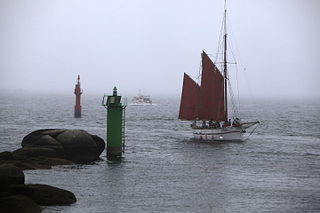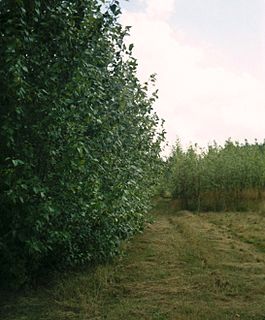
Willows, also called sallows and osiers, from the genus Salix, comprise around 400 species of typically deciduous trees and shrubs, found primarily on moist soils in cold and temperate regions.

Coppicing is a traditional method of woodland management which exploits the capacity of many species of trees to put out new shoots from their stump or roots if cut down. In a coppiced wood, which is called a copse, young tree stems are repeatedly cut down to near ground level, resulting in a stool. New growth emerges, and after a number of years, the coppiced tree is harvested, and the cycle begins anew. Pollarding is a similar process carried out at a higher level on the tree in order to prevent grazing animals from eating new shoots. Daisugi, is a similar Japanese technique.

Pollarding is a pruning system involving the removal of the upper branches of a tree, which promotes the growth of a dense head of foliage and branches. In ancient Rome, Propertius mentioned pollarding during the 1st century BCE. The practice occurred commonly in Europe since medieval times, and takes place today in urban areas worldwide, primarily to maintain trees at a determined height or to place new shoots out of the reach of grazing animals.

A nautical chart is a graphic representation of a sea area and adjacent coastal regions. Depending on the scale of the chart, it may show depths of water and heights of land, natural features of the seabed, details of the coastline, navigational hazards, locations of natural and human-made aids to navigation, information on tides and currents, local details of the Earth's magnetic field, and human-made structures such as harbours, buildings, and bridges. Nautical charts are essential tools for marine navigation; many countries require vessels, especially commercial ships, to carry them. Nautical charting may take the form of charts printed on paper or computerized electronic navigational charts. Recent technologies have made available paper charts which are printed "on demand" with cartographic data that has been downloaded to the commercial printing company as recently as the night before printing. With each daily download, critical data such as Local Notices to Mariners are added to the on-demand chart files so that these charts are up to date at the time of printing.

A sea mark, also seamark and navigation mark, is a form of aid to navigation and pilotage that identifies the approximate position of a maritime channel, hazard, or administrative area to allow boats, ships, and seaplanes to navigate safely.

A sector light is a man-made pilotage and position fixing aid that consists of strictly delineated horizontal angle light beams to guide water-borne traffic through a safe channel at night in reasonable visibility. Sector lights are most often used for safe passage through shallow or dangerous waters. This may be when leaving or entering harbour. Nautical charts give all the required information.

Salix alba, the white willow, is a species of willow native to Europe and western and central Asia. The name derives from the white tone to the undersides of the leaves.

Salix purpurea, the purple willowpurpleosier willow or purple osier, is a species of willow native to most of Europe and western Asia north to the British Isles, Poland, and the Baltic States.

The Thames Estuary is where the River Thames meets the waters of the North Sea, in the south-east of Great Britain.

Salix viminalis, the basket willow, common osier or osier, is a species of willow native to Europe, Western Asia, and the Himalayas.

The blue willow beetle, formerly Phyllodecta vulgatissima, is a herbivourous beetle of the family Chrysomelidae. It is dark with a metallic sheen that ranges from a blue color to bronze. It is distinguished from P. vitellinae by the latter more commonly displaying bronze coloration. European Phratora species can be distinguished based on morphology of female genitalia. The larvae undergo three instar stages from hatching to pupation. This beetle is found throughout Europe and Scandinavia, and occurs in China.

A hurdle is a moveable section of light fence. In the United States, terms such as "panel", "pipe panel" or simply "fence section" are used to describe moveable sections of fencing intended for agricultural use and crowd control; "hurdle" refers primarily to fences used as jumping obstacles for steeplechasing with horses or human track and field competition.

In tableware the Osier pattern is a moulded basket-weave pattern in delicate relief used round the borders of porcelain plates and other pieces of flatware. It originated in Germany in the 1730s on Meissen porcelain, and was later often imitated by other producers. It is presumed to have been devised by Johann Joachim Kaendler, the celebrated head modeller at Meissen. The name comes from Salix viminalis, or the common osier, a Eurasian species of willow, whose thin, flexible, shoots or withies were and are much used for various types of wickerwork, usually encouraged by coppicing the plants.

A navigational aid (NAVAID), also known as aid to navigation (ATON), is any sort of signal, markers or guidance equipment which aids the traveler in navigation, usually nautical or aviation travel. Common types of such aids include lighthouses, buoys, fog signals, and day beacons.

Short rotation coppice (SRC) is coppice grown as an energy crop. This woody solid biomass can be used in applications such as district heating, electric power generating stations, alone or in combination with other fuels. Currently, the leading countries in area planted for energy generation are Sweden and the UK.

Salix triandra, with the common names almond willow, almond-leaved willow or black maul willow, is a species of willow native to Europe and Western and Central Asia. It is found from south-eastern England east to Lake Baikal, and south to Spain and the Mediterranean east to the Caucasus, and the Alborz Mountains. It usually grows in riparian habitats, on river and stream banks, and in wetlands.

Pavenham Osier Beds is a 1.3 hectare nature reserve south of Pavenham, on the banks of the River Great Ouse, in Bedfordshire. It is managed by the Wildlife Trust for Bedfordshire, Cambridgeshire and Northamptonshire.

Draper's Osier Bed Stream is a small stream in southern England, in the county of Berkshire. It is formed at a weir on a section of the River Kennet running alongside the Kennet and Avon Canal, and travels east for a while, before merging with the Kennet upstream of the head of the Holy Brook stream.

An osier bed is where historically willows were planted and coppiced to produce withies, which were used for basket making, fish-traps, and other purposes. The willow species salix viminalis, known as the "common osier" was typically, although not exclusively, grown for this purpose. The marshy fringes of rivers, especially those which were often flooded and those with small islands, aits, eyots, or holts, were the most common locations for osier beds. Willow rods (cuttings) would be planted, which root easily in moist ground, and the growth of the willow withies would be cut every one or two years.






















